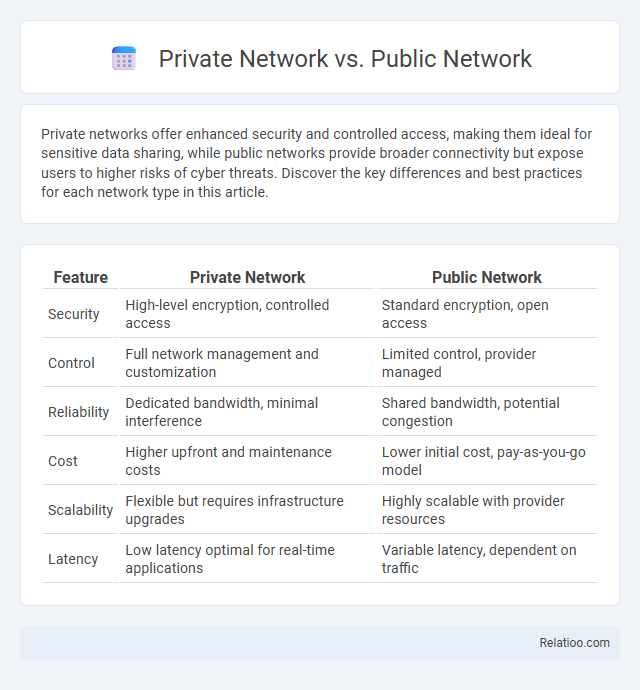Private networks offer enhanced security and controlled access, making them ideal for sensitive data sharing, while public networks provide broader connectivity but expose users to higher risks of cyber threats. Discover the key differences and best practices for each network type in this article.
Table of Comparison
| Feature | Private Network | Public Network |
|---|---|---|
| Security | High-level encryption, controlled access | Standard encryption, open access |
| Control | Full network management and customization | Limited control, provider managed |
| Reliability | Dedicated bandwidth, minimal interference | Shared bandwidth, potential congestion |
| Cost | Higher upfront and maintenance costs | Lower initial cost, pay-as-you-go model |
| Scalability | Flexible but requires infrastructure upgrades | Highly scalable with provider resources |
| Latency | Low latency optimal for real-time applications | Variable latency, dependent on traffic |
Introduction to Private and Public Networks
Private networks use restricted access protocols and IP address ranges such as 10.0.0.0/8, 172.16.0.0/12, and 192.168.0.0/16 to ensure security and control within organizations. Public networks, like the internet, provide open access and utilize globally routable IP addresses assigned by the Internet Assigned Numbers Authority (IANA). Understanding the fundamental differences in security, accessibility, and IP addressing between private and public networks is essential for effective network management and data protection.
Defining Private Networks
Private networks consist of secure, restricted-access IP address ranges defined by RFC 1918, such as 10.0.0.0/8, 172.16.0.0/12, and 192.168.0.0/16, designed for internal organizational use without direct exposure to the public internet. Public networks provide unrestricted access over the internet, enabling devices to communicate globally via public IP addresses, posing higher security risks compared to private networks. Unlike public networks, private networks enhance data privacy, control, and security by isolating internal communications from external threats.
Understanding Public Networks
Public networks are widely accessible connections that allow multiple users to share resources and data without restrictions, typically found in places like cafes, airports, and libraries. Understanding public networks involves recognizing the higher risks of data interception and unauthorized access due to their open nature, making encryption and secure login protocols essential. Your safety depends on using virtual private networks (VPNs) and strong security measures to protect sensitive information while connected to these networks.
Key Differences Between Private and Public Networks
Private networks offer controlled access with enhanced security, typically used within organizations for sensitive data and internal communications. Public networks provide open access, often unsecured, making them suitable for general internet use but vulnerable to unauthorized access and cyber threats. Understanding these key differences helps you choose the appropriate network based on your security needs and connectivity preferences.
Security Considerations: Private vs Public Networks
Private networks provide enhanced security by restricting access to authorized users only, reducing the risk of unauthorized intrusions and data breaches. Public networks expose Your data to potential threats such as malware, eavesdropping, and man-in-the-middle attacks due to their open accessibility and shared infrastructure. Implementing strong encryption protocols and using VPNs are essential for safeguarding information when connecting to public networks.
Performance and Reliability Comparison
Private networks offer superior performance and reliability due to dedicated bandwidth and controlled access, minimizing latency and downtime. Public networks, shared by multiple users, often suffer from congestion and variable speeds, leading to inconsistent performance. Hybrid network solutions strive to balance cost-efficiency with performance, but typically cannot match the reliability and speed consistency of private networks.
Cost Implications of Network Choices
Private networks typically require higher initial investment and ongoing maintenance costs due to dedicated infrastructure and enhanced security measures. Public networks offer lower upfront expenses but may incur variable costs linked to data usage and potential security risks impacting your operations. Understanding the cost implications of each network choice helps you optimize budget allocation while balancing performance and security needs.
Use Cases for Private Networks
Private networks provide secure, controlled environments ideal for businesses requiring restricted access to sensitive data and internal resources. Their use cases include remote office connectivity, secure data transfer, and IoT device management, ensuring enhanced privacy and customized network policies. You benefit from private networks by maintaining greater control over network traffic and reducing exposure to external threats compared to public or general networks.
Use Cases for Public Networks
Public networks offer extensive connectivity for general use, such as accessing the internet in coffee shops, airports, and hotels, enabling seamless communication and information exchange. Your devices rely on public networks for social media, streaming, and cloud-based services, providing convenience but requiring robust security measures due to their open nature. Unlike private networks that restrict access and network resources to specific users, public networks prioritize accessibility and broad user engagement in diverse environments.
Choosing the Right Network for Your Needs
Selecting the right network for your needs depends on security requirements, accessibility, and scalability. Private networks provide enhanced security and control, ideal for businesses handling sensitive data, while public networks offer broad accessibility but less protection. Hybrid approaches combine the strengths of both, allowing you to balance flexibility with security based on your specific use case.

Infographic: Private Network vs Public Network
 relatioo.com
relatioo.com